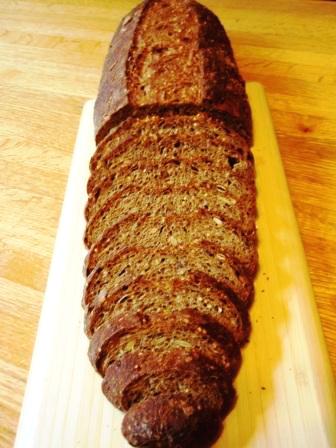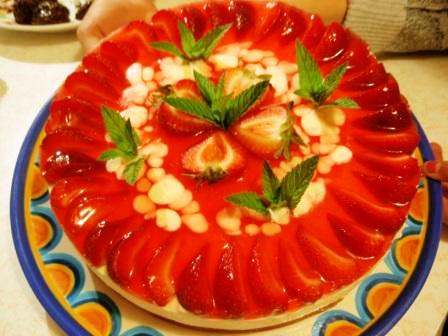
Peter Reinhart’s Multigrain Struan & more desserts
Struan is the bread that truly launched his bread baking career, Reinhart says (p. 102). In Gaelic, struan means “the convergence or confluence of streams,” a good description for multigrain breads where all kinds of grains and seeds are coming together (the combinations are, of course, endless).
Because I love breads full of grains and seeds, I have bought Peter Reinhart’s book “Whole Grain Breads.” Most of the recipes in there consist of three parts: a soaker (part of the flour, the seeds and grains and part of the salt are soaked in water or often in milk, buttermilk or yoghurt for 12-24 hours), a biga (to be refrigerated for at least 8 hours or up to three days) and the final dough.

The flour for this multigrain Struan is whole wheat (67%) and to it I added in about equal parts: sesame, pumpkin, sunflower and flax seeds, and millet (seeds and grains 33%). Reinhart says that he prefers to cook the millet, but it can also be added to the soaker uncooked. I prefer it that way since it gives a beautiful crunch to the bread that we like very much.
I made a school lunch with this bread for my 15 year-old son and thought he’d tell me upon his return to never use such a seedy bread again. To my big surprise he announced that this was the best sandwich ever.

For guests I made one of my favorite desserts. It’s a Swiss recipe called “Quarktorte” which in English gets translated as cheese cake. Most cheese cakes in the US are made with cream cheese as you all know, in Switzerland however we use a product called “Quark” which is a type of fresh cheese, much lighter than cream cheese (kind of like a firm yoghurt) and very tasty. It comes in plain form (which is needed for this dessert) or in many fruit styles. It is available in the US in some specialty stores, at about 10 times the Swiss price. To substitute I use sour cream light. I had to get used to the different taste, but it works very well. Only the base gets baked, the rest is a mixture of egg yolks, sugar, vanilla, stiff egg whites, sour cream, whipped cream and gelatin. I always import my yearly supply of gelatin leaves from Europe whenever I go there, thus I have never had to get used to gelatin in powder form, the only one readily available here, as far as I know.
It’s an elegant, fresh dessert that has a somewhat airy texture and the appearance of being very light.

I also made this typical, very common and simple French summer dessert: a clafoutis with apricots and blueberries. It is a very easy and tasty way to use up fresh fruit. The most common version is with cherries.

And finally for brunch at our neighbors this past Sunday I baked these cinnamon rolls (I myself don't like cinnamon in sweets much, I prefer it in savory dishes). They came out very light and fluffy. I used a recipe from the King Arthur site and substituted the potato flakes (which I don't have) with a freshly cooked potato (before cooking it was around 120g) that I mashed finely with a little water. This ingredient, I read, makes cinnamon rolls very soft, and it's true, as several people commented on how fluffy and light they were.


Comments
oh oh! So many memories come flooding back looking at that cheesecake! Can you post your modified recipe for those of us in the US who would love to try it again?
Also the one for your clafoutis... I am thinking one of those with peaches would be a perfect way to wrap up the summer here!
... come flooding back. Have you lived in Switzerland/Europe or traveled around there and cruised through all the bakeries and pastry shops? :)
all of it :-) And, I especially like crunchy, seedy breads like your struan. Very nice pictures!
Beautifully baked multigrain Straun and lovely delicious desserts! I love your Quarktorte, it's decorated so nicely and a favorite of mine is clafoutis and the cinnamon rolls with the addition of potato...it does make them so tender and delicious!
Sylvia
... for your nice comments! I'll post the recipes very soon, just give me a couple of days. My semester has started and I am getting lots of student e-mails (from my online class) that require my attention. In a few days, things will hopefully run smoothly.
both favorites and yours are beautiful as is the Quarktorte! Leaf gelatin is available in the US by mail order, although I have no idea of the price comparison.
Looking forward to seeing your recipes.
Betty
I was so surprised to see the Quark mentioned in this post. I have looked everywhere for that particular cheese. I finally stopped looking about a year ago. I did find a recipe to make it and it seems simple enough, but I never did so I can't vouch for it. It was made with just milk and buttermilk and needed time to "come together".
I'd be happy to send / post it if anyone wants to give it a try
-Susie
... is very easy, it's true. You should try it some time. There are lots of different approaches, you just need to find the one that works for you.
I always make my own yoghurt / Greek yoghurt or Labneh (just milk and yoghurt culture).
I also make paneer (Indian cheese) with milk and lemon juice. Depending on how long you let it drain, you also get a type of ricotta in the first stages which also resembles Quark a lot.
A type of Quark can be made with milk and buttermilk (as you say), however in order to make the real thing, you need rennet, which converts milk protein (casein) from a soluble to an insoluble state.
My quark recipe only uses buttermilk and milk but I do have rennet that I use when I make mozzarella. could you give me your recipe for quark using the rennet. I haven't found one like that yet.
thanks!
-Susie
Chouette, I found the Multigrain Struan Recipe online and I thought I might share it here to save you some work.
(And if the link doesn't work: books.google.com, --> search for Whole Grain Reinhart, the search in the book for multigrain Struan)
The bread looks utterly delicious and I will put it in my "to-do" folder!
Salome
...that you found the link to that recipe! Thank you for posting it here.
hmpf, it's somewhat frustrating though, this online recipe. first of all, it's not possible to print it out, secondly there is no preview for the instructions about how to handle the dough. it's just the formula. anyway, I think I will be able to figure it out!
Salome
Hmm...I think now that it's fall I should graduate into crusty and grain breads!
Gorgeous! I have to admit that I'm mainly adding a comment so that I'll get a thread notification for when you post the recipes!
Summer
I was just reading through PR Whole Grain book last night planning which one I wanted to start with and this is probably the one. We both love lots of nuts and seeds in our bread. Your desserts look/sound amazing and make me want to head home and straight into the kitchen. Thanks so much for sharing all of these.
Melody in Santa Fe
Your Quarktorte is traditionally made from the same cheese as used for a pastry called "vatrushka" back home (in Latvia and Russia). The cheese we use for it is called "tvorog". According to Wikipedia, it is the same as quark. You can get "tvorog" in Russian grocery stores (often called European grocery stores) if you have one where you live. Some of it is imported, and some made in the US. I have even seen organic "tvorog". The resulting pastry is so yummy.... Perhaps you can use it and have the taste you are used to? I love your decorating of the cake. I have to learn how to make my cakes prettier.
Here is a link to an on-line store that sells it. I have never bought from them, as I buy my "tvorog" locally.
http://www.russianfoods.com/showroom/group003DE/vendor003E7/default.asp
Yulika
...Yulika. It looks like precisely the same thing. We have a Polish store about 30 min. from where I live, next time I am in that area I'll check if they also carry 'tvorog'. That would be wonderful!
Thanks again, to everyone, for the very nice comments! What a friendly community TFL is!
Quarktorte:
First I have to give you a warning: This Quarktorte (just like Tiramisu) has raw eggs, so be careful. I always use the freshest eggs I can get my hands on or you could try pasteurized eggs.
Cake base (the part that is baked):
-3 egg yolks, 1 ½ Tbsp hot water, 90g sugar – mix very well until foamy
-90g flour, pinch of salt, 3 stiff egg whites – add this very carefully to the previous mixture, fold it in with a rubber spatula.
Pour it into a round, buttered cake form (mine is 10“, but smaller ones work too) and bake it in a 400F oven for 10-15 min. Let it cool.
Put this ‘biscuit’ (without the bottom of the cake form) onto a big, flat serving plate and use the ring of your cake form or an expandable ring specific for this type of dessert around the cake base for support.
I then moisten the sponge base with a few Tbsp of milk. After that I put a layer of fruit, in this case strawberries, or anything you have (in winter I use pineapple pieces out of a can) onto the sponge.
Quark mixture:
-3 egg yolks, 150g sugar, 1½ tsp vanilla – mix well until foamy
-Add 450-500g of quark or sour cream (regular or light), fold it in very well
-Now to the gelatin: I use 7 leaves (I just read up on this and found that 6 leaves correspond to 3 tsp of powder gelatin, thus use 3 ½ tsp for this recipe). If you use leaves, soak them in cold water for about 5 minutes until they are limp. Squeeze most of the water out of them and put them into a little saucepan, with 1 or 2 tsp of water. Warm it very carefully on low heat until everything is dissolved, remove it from the heat and add two or three Tsp of your egg/quark mixture to it. Mix it very well with a whisk, then add that mixture to your entire egg/quark mixture. Mix it very well, then put the mixture into the fridge for a few minutes – it’ll settle a little bit, but don’t leave it too long as it will solidify and you won’t be able to incorporate the remaining ingredients.
If you use powder, just follow the instructions on your package. Don’t let gelatin stop you from making this dessert, it’s really not difficult. Plus, you are all bakers, if you can handle sourdough starters, then gelatin is nothing compared to that! :)
-Beat 3 egg whites until very stiff
-Whip 2.5dl of cream to stiff peaks
Fold both the cream and the egg whites into the mixture that you have removed from the fridge, until it is all completely integrated and you have a foamy mixture. Put it on top of your fruit in the cake ring and smoothe the top. Cover it with plastic and put it back into the fridge for some 4 hours. It will become solid enough so that you can cut it into beautiful cake wedges when ready to serve. After 4 hours or so, take it out of the fridge and decorate it with fresh fruit and, in my case, peppermint leaves.
[Finally, but this is purely decorative and certainly not necessary, I add a red berry gelatin layer just like they do in pastry shops, also imported from Switzerland (sorry about all these problematic ingredients)]. Put it back into the fridge until ready to serve. Before serving, remove the cake ring very carefully (cut around it first with a long knife). If your gelatin worked, and this is always the critical moment, it will hold up!
PS: With regards to the fruit, you can put them on the sponge and on the top, or only on the sponge and nothing onto the quark mixture, or only on top of the quark mixture. Anything works and will taste very good. Enjoy!
***
Now on to the clafoutis:
Use any fruit you have, or a combination.
Egg mixture > combine with whisk or blender:
3 eggs
½ to 1 cup of sugar, depending on the sweetness of your fruit and/or your sweet tooth. In the case of my apricots and blueberries, I believe I put the entire cup
a pinch of salt
1 cup of whole milk
1½ tsp vanilla
½ cup of sifted flour
Butter a baking or pie dish (rectangular or round, glass or porcelain or whatever you have) and arrange your fruit, in a decorative pattern or however you wish. Pour the egg mixture on top and bake in a 350F oven for 40-50 min. It’ll puff up and the edges should be nicely golden. Insert a tooth pick to see that the mixture is baked enough, it should come out clean. Let it cool to room temperature (it will deflate a little), then dust it with powdered sugar. Or serve it out of the fridge.
Bon appétit!